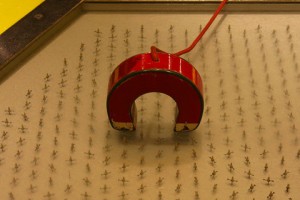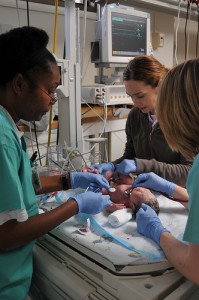
Just like Goldilocks wouldn’t eat porridge that was too hot or too cold, blood vessels won't grow properly in tissues that are too stiff or too loose. (Project Gutenberg/Wikimedia Commons)
In the tale
Goldilocks and the Three Bears, Goldilocks tries all of the bears’ porridge, chairs and beds, finding that only the little bear’s things were just right. Everything else was a little off for her…too hot or too cold, too hard or too soft and so on.
Similarly, for everything to work as it should in the body, things need to be just right. Blood pressure shouldn’t be too high or too low; organs can’t be too big or too small, etc.
Donald Ingber, MD, PhD, and his lab in Boston Children’s Vascular Biology Program take this “just right” approach when thinking about how organs and tissues are structured. Recently, he and a member of his research staff, Akiko Mammoto, MD, PhD, discovered that by changing the stiffness of the surrounding tissues—not too loose and not too tight— they could keep blood vessels from leaking. Their finding could have real consequences for people with sepsis or other diseases featuring leaky vessels. Full story »

(Ryan Somma/Flickr)
There’s no other way to say it: sepsis is a horrible disease. It typically starts with a runaway bacterial infection in the blood, followed by a runaway immune response that severely damages the body it’s trying to save. The results: shock, multiple organ failure and—in between 210,000 and 375,000 people in the United States alone every year—death.
Part of the problem is that the methods available for treating sepsis aren’t particularly good. Antibiotics can kill the bacteria, but that still leaves bacterial debris floating in the bloodstream, fueling the already over-excited inflammatory response.
Removing the bacteria altogether—as fast as possible—would be the better solution. At least that’s what Daniel Kohane, MD, PhD, thinks. His lab at Boston Children’s Hospital’s Division of Critical Care Medicine has developed a new approach that combines magnetic nanoparticles, a synthetic molecule (called bis-Zn-DPA) that binds to the bacteria, and magnetized microfluidic devices to pull bacteria from the blood quickly and efficiently. Full story »

Sepsis, a serious, hard-to-diagnose threat in the NICU, can interfere with a baby's development even when cleared with antibiotics. (Image: Army Medicine/Flickr)
Sepsis, or bacterial infection of the bloodstream, is a grave threat to premature infants in the neonatal intensive care unit (NICU) who have catheters and intravenous lines. Even when antibiotics clear the infection itself, the inflammation that it causes can do just as much damage. Not only can sepsis and the resulting inflammation interfere with fragile preemies’ ability to gain weight, but a growing literature suggests that they can impair brain development.
Preventive measures can now avoid many cases of sepsis, but those that slip through can be hard to detect in newborns.
“Newborns can’t speak, and they have unique immune systems, so they tend not to have fevers or show clinical signs,” explains Ofer Levy, MD, PhD, of the Division of Infectious Diseases at Boston Children’s Hospital. “There may be irregular breathing or increased heart rate, or the baby may be acting a little ‘off,’ but these signs are pretty nonspecific. There’s a tremendous need for better diagnostics in this field.”
Levy and colleagues recently described a mouse model that, for the first time, captures the effects of sepsis on the newborn immune system. They and others have begun using it to identify diagnostic markers and better treatments. Full story »











